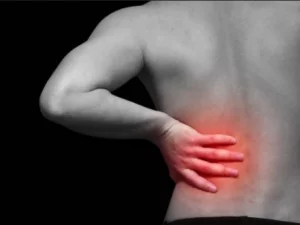We wanted to talk to you today about something that we are passionate about … PAIN. But maybe not in the way you are used to hearing about it.
Pain is the enemy right? Cover it up, cut it out, just get rid of it!
Having some pain is what likely led you to this page in the first place.
But what if pain isn’t actually the enemy?
Then what is it?
Let’s first identify what pain is NOT.
Pain is NOT …
1 – Pain is NOT directly related to tissue damage
This is something you actually already know. Have you ever found a scratch/dried blood on your body and wondered “When did that happen?”
Tissue damage occurred, yet your body didn’t have pain.
2 – Pain is often NOT related to MRI or X-ray Findings
We already wrote a whole blog about deciding if getting an MRI or X-ray is worth it for the most common pain in the world, that you can check out here.
Most “abnormal findings” on imaging are found in people WITHOUT pain.
This concept is so widely known in the medical community that 31 worldwide medical organizations recommend NOT getting imaging until after trying conservative (non surgical) care unless a trauma has occurred.
3 – Pain is NOT always accurate in its location
A common screening for a heart attack is left shoulder pain … if pain were accurate wouldn’t the heart hurt?
This is called a referral of pain, pain in one region generated from another region.
This happens all over the body and is the reason that you can’t just look at the body region that has pain.
4 – Pain is NOT BAD
The inability to feel pain is known as Congenital Insensitivity to Pain.
These are individuals who literally cannot feel pain.
While those in pain for a long time feel like this would be a good tradeoff these individuals are constantly at risk for life threatening harm: walking on broken bones, not knowing they have wounds, etc.
Much like if you were unable to produce the sensation of hunger at all you might actually starve in extreme cases.
Pain is actually NECESSARY!
What is Pain Then?!

Pain is quite simply a signal to get you to create a change based on what your brain has deemed threatening. Similar to a check engine light on a car.
As we alluded to above, another signal that is worth comparing pain to is …. Hunger.
Imagine every time you got hungry you decided to take a pill or injections to cover up the sensation. Or the go to treatment for hunger was to remove the stomach.
Sounds kind of … drastic right? Why do we approach pain this way then?
Hunger lets us know we need to do something… EAT!
Covering up pain with medications, injections, or trying to cut it out with surgery often leave us with very temporary results. The pain often comes back, even worse, after trying one of these methods.
Now, just like surgery can at times be helpful in extreme cases for hunger management, we do want to acknowledge the same can be said of pain, but only in specific cases.
Like hunger, pain is connected to the 4 Key Habits we go over with every patient: Stress, Sleep, Nutrition, and our personal favorite Movement.
Hunger, Pain, and Stress
Stress can greatly affect hunger signals, from changing the actual wants of what we are hungry for (comfort food) to being so stressed our stomach is in knots and we just can’t get ourselves to eat.
It does the exact same to pain. In fact comparing the ability to feel pain in 80 individuals found “significant differences between pain thresholds under non-stress and stress conditions, indicating an increased sensitivity to pain under stress.”
Essentially the more stress you are under, the easier it is to feel pain, and things that are often not deemed painful under non stressful conditions are deemed painful when stressed.
And then having pain can often produce stress, and a repeating cycle starts to occur.

Even worse is that chronic stress actually releases the SAME CHEMICALS in the brain that pain does!
Hunger, Pain, and Sleep

Replace the word stress with sleep above and we almost get the exact same effects on hunger. Less sleep and either cravings for worse food OR so much lack of sleep that we are simply not hungry at all.
Just like hunger, pain is affected as well!
A single night of restricted/below recommended levels of sleep can increase pain sensitivity up to 15%.
The recommendations for sleep is 7-9 hours a night. Almost a third of Americans are below this.
Pain can often disturb sleep and create a repeating cycle.
Hunger, Pain, and Nutrition

While we are not here to recommend a specific diet, as this should be very individualized, just one example of how nutrition can affect pain can be found in sugar consumption.
Sugar is actually one of the most addictive things in the world, the more you eat, the more you want.
Unfortunately, sugar ALSO tops the list of foods that may increase joint and muscle inflammation, with sugar releasing proinflammatory substances into the body.
Inflammation being one of the most managed pains in the world.
Hunger, Pain, and Movement

We may be a little biased but this is our favorite section.
Moving well and often, in the form of workouts, helps not only control how hungry we are but what we are hungry for.
It also has an amazing connection to pain. If pain is the check engine light and the body saying we need to do something, what are we supposed to do?
More often than not the answer is to MOVE.
The body is incredible. You get it moving right and it will start to adapt and automatically begin to correct our sleep, our food cravings, and our stress levels.
Since you are still reading, it’s probably worth a guess that you are currently experiencing some form of pain or movement limitation that you hope to overcome.
Most of the time, pain during a movement is the body sensing a threat. A lack of coordination possibly coming from any of the above reasons or simply lack of training and it’s using every ounce of its resources to counteract and protect itself. It’s truly amazing.
What a Doctor of Physical Therapy can do is help your body rewrite its natural protective reflexes by slowly, gradually, reintroducing proper movement that will address this coordination and protectiveness. This allows proper movement and full range to be restored.
Slowly increasing the prescribed amount of movement and measured load reduces pain. This is why physical therapy and conservative (non surgical) care is CONSTANTLY effective in pain management.
Many professionals will tell you surgery is your only option.
Drs. with specialist degrees will tell you abandoning your normal favorite exercise is your only way to reduce the pain.
But it’s simply not true. This is why we do what we do.
You have an amazingly adaptable body that, taken care of properly, can give you a life full of activity and joy. You can continue with your favorite activities as long as you allow a trained professional to help your body rewrite the way it moves.
There is NO bad movement, just movements you are not prepared for.
The proper prescription and performance of movements WORKS. It’s why we truly believe movement is medicine.
Now What?
So … why do you have pain?
It’s complicated but actually necessary and you NEED to listen to it.
Is pain bad? Not if you use it as the signal for change it actually is and actually make the RIGHT change!
You can overcome it but you’ll need a guide who is going to treat the whole YOU and not just your body part.
At Gray Duck Physical Therapy we always take the time to know YOU. The whole you, not just the sliver of you that is your pain right now. You’re so much more than that!
We specialize in helping motivated individuals get back to the sports and activities they love without taking time off or undergoing invasive irreversible treatments.
Our patients are Real People who have Real Pain. Who are willing to put in Real Work to get Real Results.
Click HERE to start your journey to an active life free of pain.
🚫The content in this is NOT medical or health advice and is intended for educational and entertainment purposes only. See a healthcare professional if you have any questions about your individual healthcare needs.🚫
References:
Abdallah CG, Geha P. Chronic Pain and Chronic Stress: Two sides of the same coin? Chronic Stress (Thousand Oaks, Calif.) 2017 Feb 1: 10.1177/2470547017704763
Avena NM, Rada P, Hoebel BG. Evidence for sugar addiction: behavioral and neurochemical effects of intermittent, excessive sugar intake. Neurosci Biobehav Rev. 2008;32(1):20-39.
Bärebring L, Winkvist A, Gjertsson I, Lindqvist HM. Poor Dietary Quality Is Associated with Increased Inflammation in Swedish Patients with Rheumatoid Arthritis. Nutrients. 2018 Oct 18;10(10):1535.
Cuff A, Parton S, Tyer R, Dikomitis L, Foster N, Littlewood C. Guidelines for the use of diagnostic imaging in musculoskeletal pain conditions affecting the lower back, knee and shoulder: A scoping review. Musculoskeletal Care. 2020 Aug 4.
Krause AJ, Prather AA, Wager TD, Lindquist MA, Walker MP. The Pain of Sleep Loss: A Brain Characterization in Humans. J Neurosci. 2019 Mar 20;39(12):2291-2300.
Tatyana Reinhardt, MD, Nikolaus Kleindienst, MD, Rolf-Detlef Treede, PhD, Martin Bohus, MD, Christian Schmahl, PhD, Individual Modulation of Pain Sensitivity under Stress, Pain Medicine, Volume 14, Issue 5, May 2013, Pages 676–685



